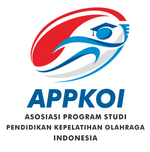MENGUAK LITERASI FISIK: STUDI PADA PESERTA DIDIK SD FAJAR INDAH DKI JAKARTA
DOI:
https://doi.org/10.24114/jp.v8i2.64341Keywords:
Literasi Fisik, Peserta DidikAbstract
Penelitian ini bertujuan untuk menganalisis tingkat literasi fisik siswa kelas 4, 5, dan 6 di SD Fajar Indah DKI Jakarta berdasarkan empat indikator utama: motivasi, kompetensi fisik, pengetahuan dan pemahaman, serta partisipasi aktif. Penelitian ini menggunakan pendekatan kuantitatif deskriptif dengan pengumpulan data melalui kuesioner dan observasi. Data dianalisis secara statistik untuk mengidentifikasi tren dan perbedaan antar kelas. Hasil menunjukkan bahwa motivasi dan partisipasi aktif siswa berada pada kategori tinggi, sementara kompetensi fisik dan pengetahuan serta pemahaman menunjukkan tren meningkat, tetapi masih perlu penguatan pada aspek kognitif. Kesimpulan menunjukkan bahwa program pendidikan jasmani di SD Fajar Indah telah efektif dalam meningkatkan literasi fisik siswa, terutama pada aspek afektif dan keterlibatan aktif. Namun, peningkatan pada dimensi kognitif perlu dilakukan untuk mendukung perkembangan literasi fisik secara holistik.References
Allingham, S., Maude, P., & Whitehead, M. (2019). Physical literacy in early childhood. The Physical Development Needs of Young Children, September, 18–32. https://doi.org/10.4324/9780429469831-3
Arikunto, S. (2011). Prosedur Penelitian: Suatu Pendekatan Praktik (4th ed.). Rineka Cipta.
Cairney, J., Dudley, D., Kwan, M., Bulten, R., & Kriellaars, D. (2018). Physical literacy, physical activity, and health: Toward an evidence-informed conceptual model. Sports Medicine, 49(3), 371–383. https://doi.org/10.1007/s40279-018-0988-y
Chen, A., Sun, H., & Zhu, X. (2017). Physical literacy and its policy implications in China. Journal of Sport and Health Science, 6(4), 365–366. https://doi.org/10.1016/j.jshs.2017.09.004
Chen, A. (2015). Operationalizing physical literacy for learners: Embodying the motivation to move. Journal of Sport and Health Science, 4(2),
Deci, E. L., & Ryan, R. M. (1985). Intrinsic motivation and self-determination in human behavior. Springer.
Gallahue, D. L., & Ozmun, J. C. (2012). Understanding motor development: Infants, children, adolescents, adults (7th ed.). McGraw-Hill Education.
Giblin, S., Collins, D., & Button, C. (2014). Physical Literacy : Importance , Assessment and Future Directions. 1177–1184. https://doi.org/10.1007/s40279-014-0205-7
Gustian, U., Supriatna, E., & Purnomo, E. (2019). Learning Activity to Develop Physical Literacy in Kindergarten. 278(YISHPESS), 204–207. https://doi.org/10.2991/yishpess-cois-18.2018.52
Kementerian Kesehatan Republik Indonesia. (2018). Riset Kesehatan Dasar (Riskesdas) tahun 2018. Kementerian Kesehatan Republik Indonesia.
Lundvall, S. (2015). ScienceDirect Physical literacy in the field of physical education e A challenge and a possibility. Journal of Sport and Health Science, 4(2), 113–118. https://doi.org/10.1016/j.jshs.2015.02.001
Mandigo, J., Francis, N., Lodewyk, K., & Lopez, R. (2012). Physical literacy for educators. Physical & Health Education Journal, 75(3), 27–30.
Permana, R., & Habibie, A. (2020). Analisis Assesmen Literasi Jasmani dengan Kebutuhan Pembelajaran PJOK di Sekolah Dasar Muhammadiyah Tasikmalaya. 221–226.
Thomas, J. R., Lee, A. M., & Thomas, K. T. (2019). Motor development: Understanding physical literacy through developmental stages. Kinesiology Review, 8(1), 9–16. https://doi.org/10.1123/kr.2019-0011
Whitehead, M. (2010). Physical literacy: Throughout the lifecourse. In Physical Literacy: Throughout the Lifecourse. https://doi.org/10.4324/9780203881903.
Downloads
Published
Issue
Section
License
Copyright (c) 2024 Muh. Ali Akbar, Harry Saputra Nasution, Wendri Maryadi

This work is licensed under a Creative Commons Attribution-ShareAlike 4.0 International License.
Authors who publish with this journal agree to the following terms:
- Authors retain copyright and grant the journal right of first publication with the work simultaneously licensed under a Creative Commons Attribution License that allows others to share the work with an acknowledgment of the work's authorship and initial publication in this journal.
- Authors are able to enter into separate, additional contractual arrangements for the non-exclusive distribution of the journal's published version of the work (e.g., post it to an institutional repository or publish it in a book), with an acknowledgment of its initial publication in this journal.
- Authors are permitted and encouraged to post their work online (e.g., in institutional repositories or on their website) prior to and during the submission process, as it can lead to productive exchanges, as well as earlier and greater citation of published work (See The Effect of Open Access).
- This work is licensed under a Creative Commons Attribution-ShareAlike 4.0 International License.























